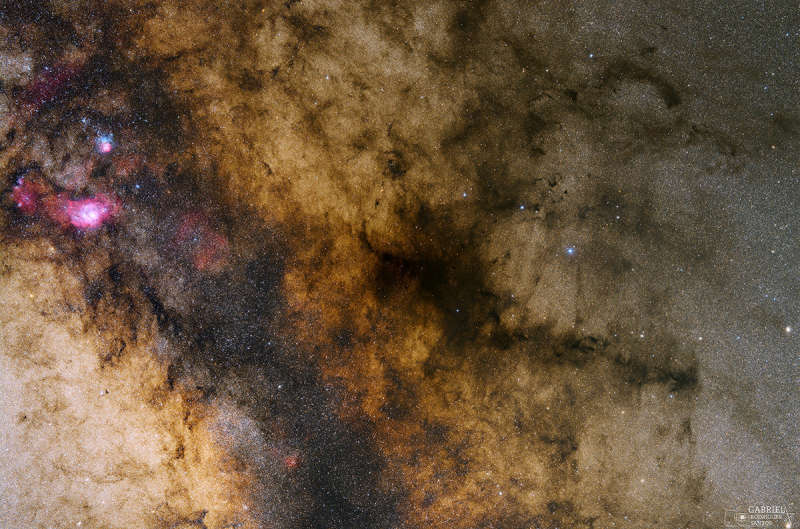Credit & Copyright: Gabriel Rodrigues Santos
Explanation:
Dark markings and colorful clouds
inhabit this stellar landscape.
The deep and expansive view spans more than 30 full moons across
crowded star fields toward the center of our Milky Way Galaxy.
Cataloged
in
the early 20th century by astronomer
E.
E. Barnard,
the obscuring interstellar dust clouds seen toward the right
include
B59, B72, B77 and B78,
part of the Ophiuchus molecular cloud complex a mere 450 light-years away.
To the eye their combined shape
suggests a pipe
stem and bowl, and so the dark nebula's popular name is
the Pipe Nebula.
Three bright nebulae gathered on the left are
stellar nurseries some 5,000 light-years distant toward
the constellation Sagittarius.
In the 18th century astronomer
Charles
Messier included
two of them in his catalog of bright clusters and nebulae; M8, the
largest of the triplet,
and colorful M20 just above.
The third prominent emission region includes NGC 6559 at the far left.
Itself divided by obscuring dust lanes, M20 is also known as
the Trifid.
M8's popular moniker is
the Lagoon Nebula.
1999 2000 2001 2002 2003 2004 2005 2006 2007 2008 2009 2010 2011 2012 2013 2014 2015 2016 2017 2018 2019 2020 2021 2022 2023 2024 2025 |
Yanvar' Fevral' Mart Aprel' Mai Iyun' Iyul' Avgust Sentyabr' Oktyabr' Noyabr' Dekabr' |
NASA Web Site Statements, Warnings, and Disclaimers
NASA Official: Jay Norris. Specific rights apply.
A service of: LHEA at NASA / GSFC
& Michigan Tech. U.
|
Publikacii s klyuchevymi slovami:
dark nebula - temnaya tumannost' - Milky Way - Mlechnyi Put'
Publikacii so slovami: dark nebula - temnaya tumannost' - Milky Way - Mlechnyi Put' | |
Sm. takzhe:
Vse publikacii na tu zhe temu >> | |
